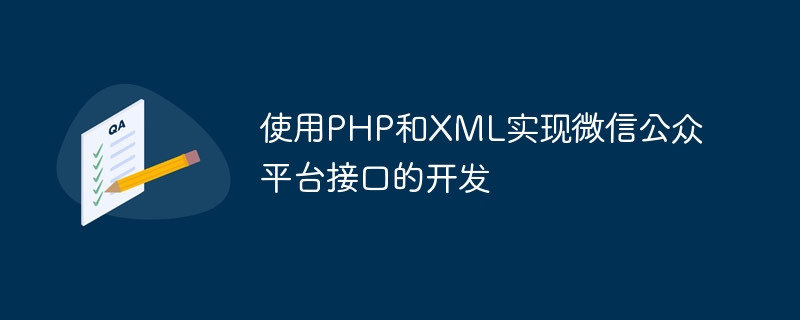

Using PHP and XML to implement the development of WeChat public platform interface
WeChat public platform is a very popular social media platform. Many companies and individuals hope to use it through their own public account to interact with fans. During the development process, we need to use XML for data transmission and interaction according to the interface specifications provided by WeChat. This article will introduce how to use PHP and XML to implement the development of the WeChat public platform interface, and provide some code examples.
First of all, we need to understand the basic principles of the WeChat public platform interface. When a user sends a message to the official account or performs other operations, the WeChat server will send the corresponding data to the developer server in the form of a data packet in XML format. After receiving the data packet, the developer server needs to parse and process the data and return the corresponding XML data packet according to WeChat's requirements. Therefore, we need to use functions related to XML parsing and generation in PHP.
In PHP, we can use the simplexml_load_string() function to parse the XML data packet received from the WeChat server and convert it into a simple XML object. Here is a simple example:
$xml = file_get_contents('php://input');
$data = simplexml_load_string($xml);In the above code, we use the file_get_contents() function to read the XML data in the input stream and pass it to the simplexml_load_string() function for parsing. The parsed data will be stored in the $data variable and can be further processed as needed.
Next, we need to process the data in $data according to WeChat’s requirements and return the corresponding XML data packet. We can use the simplexml_load_string() function to generate an XML object, and then use related functions to set XML nodes and attributes. Here is a simple example:
$response = new SimpleXMLElement('<xml></xml>');
$response->addChild('ToUserName', $data->FromUserName);
$response->addChild('FromUserName', $data->ToUserName);
$response->addChild('CreateTime', time());
$response->addChild('MsgType', 'text');
$response->addChild('Content', 'Hello, world!');
echo $response->asXML();In the above example, we created an empty XML object $response and added some nodes and attributes using the addChild() function. Finally, we use the asXML() function to convert the $xml object into an XML format string and output it to the browser. In this way, we can return the response to the WeChat server.
In addition to the above examples, we can also use more XML nodes and attributes according to the different needs of the WeChat public platform interface. For example, when a user sends a text message to the official account, we can use the following code to generate a reply message:
$response = new SimpleXMLElement('<xml></xml>');
$response->addChild('ToUserName', $data->FromUserName);
$response->addChild('FromUserName', $data->ToUserName);
$response->addChild('CreateTime', time());
$response->addChild('MsgType', 'text');
$response->addChild('Content', '你发送的消息是:' . $data->Content);
echo $response->asXML();In the above code, we add a Content node and use the content of the message sent by the user as its value. In this way, messages sent by the user will be returned unchanged.
In summary, it is not complicated to use PHP and XML to develop the WeChat public platform interface. With simple XML parsing and generation functions, we can easily process the received XML packets and return the corresponding XML packets. At the same time, according to WeChat's requirements, we can write corresponding XML nodes and attributes according to our own needs. I hope this article can help readers better understand and use PHP and XML to develop WeChat public platform interfaces.
The above is the detailed content of Development of WeChat public platform interface using PHP and XML. For more information, please follow other related articles on the PHP Chinese website!




